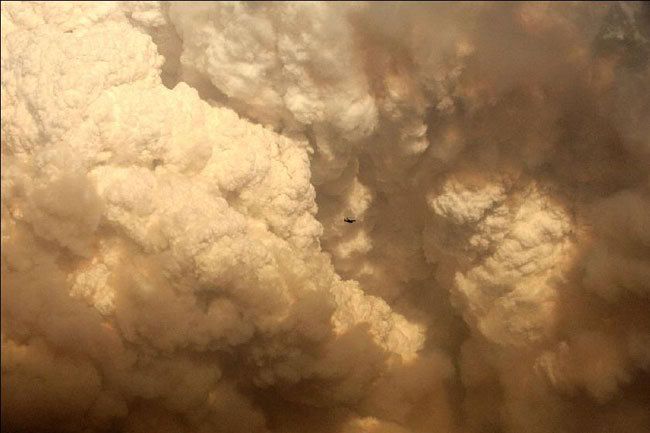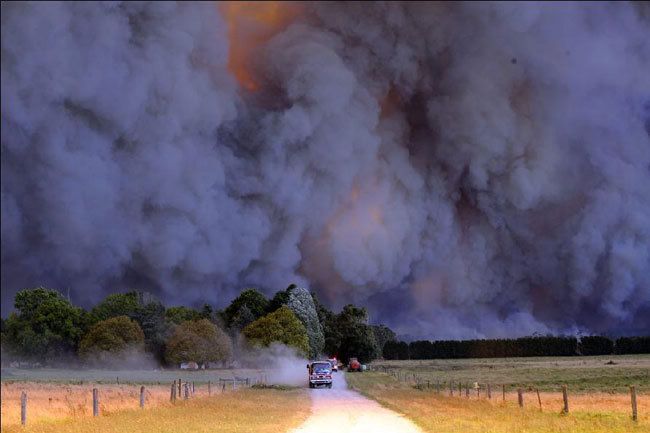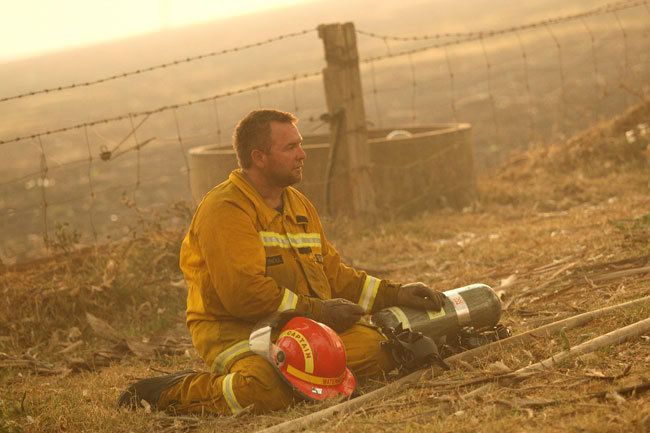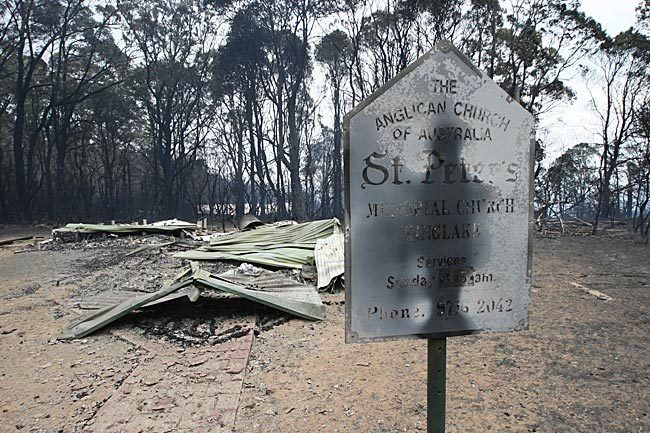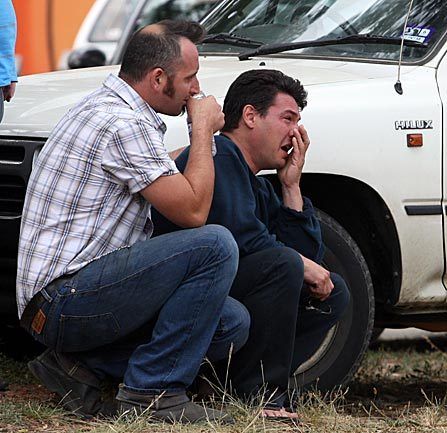Re: Australia Wildfires
This is a long article, so give it a miss if it is too much.
Got to do it in 2 parts as text is too long.
It explains very well the 1st day of the bushfires, how many there were and what actually happened.
Keep in mind there have been 7 days pass since, so a lot has happened since.
Cheers
Phillip
How the battle with Victoria's bushfires was fought and lost
Font Size

ecreaseIncreasePrint Page

rint
INSIDE STORY: Cameron Stewart and Corrie Perkin | February 14, 2009
Article from: The Australian
BRUCE Esplin woke at 6am last Saturday with a gnawing feeling in his gut. Victoria's Emergency Services Commissioner knew the odds were not good for the 3582 firefighters and emergency workers who had been placed like toy soldiers across the breadth of his state.
"We were about to face weather beyond our experience, and I just had this feeling of dread," Esplin says.
Across town, Ewan Waller, the Government's chief fire officer, was also on edge. By 7.30am he was already sitting in the Integrated Emergency Co-ordination Centre in central Melbourne, otherwise known as the "war room", where he would spend the next 15 hours alongside chief Country Fire Authority officer Russell Rees. These two men would jointly manage the defence of Victoria against the worst weather forecast in memory.
Barely 60km to the north, thousands of families scattered across the hillside regions of Kinglake, St Andrews and Marysville were waking up to a lazy Saturday. Many of these were tree changers: city commuters who had embraced the lush forested hills for both lifestyle and financial reasons.
They were mostly young families with young kids, and with the temperature tipped to hit 44C with strong, hot wind gusts, it was cooler to stay in their hillside homes than travel.
In Marysville, 20-year-old Lucie O'Meara spent the morning making pancakes for her husband, Luke, and their seven-month-old daughter, Charlotte. She then sat down at her computer and wrote on her Facebook site: "I am so enjoying the viewfrom my desk, Marysville is beautiful."
Just before 9.30am, Stuart Coombs arrived at the Victorian weather bureau's headquarters in Melbourne's Docklands to start his shift.
One of his jobs was to compile thunderstorm warnings. But when he scanned the charts he saw something that disturbed him even more than the "very dreadful" forecast of the previous night. "The thunderstorm conditions (meant) we knew there would be fire activity (from lightening strikes)," Coombs said.
Even so, for the next few hours, the war room was buoyed by what they saw. Although they were concerned by a fire that had jumped containment lines in the Bunyip State Forest, east of Melbourne, fire activity around the state was modest.
The day, which Premier John Brumby had warned on Friday might be the state's worst, had started well.
"There was a sense of 'well, we've got to lunchtime and so far so good'," Esplin says. "But we knew the most dangerous part of the day would be late afternoon."
None of the 60-odd officials from multiple agencies who had gathered in the war room were aware the spark that would set off the worst day in Victoria's history had already been lit.
At 11.30am, Liz Jackson looked out the window of her house in Kilmore East, a township near the Hume Highway, 60km north of Melbourne, and saw smoke.
It came from the hill opposite her home where a single power pole stood. She called the CFA but the fire spread quickly, fanned by increasingly strong hot northerly wind gusts of up to 125km/h.
WANDONG
In the nearby community of Wandong, former CFA firefighter Chris Isbister says he witnessed the moment when this little fire grew fangs. "Me and my mate headed up the highway to check it out and we saw it go into the pine plantation and get really big."
He returned home to prepare the house, while watching the fire come closer. Police advised residents to evacuate, but Isbister and two mates stayed and watched the fire's progress.
"We watched the actual fire roll down one hill and up another," Isbister says. "The wind was so unbelievably strong, we had to hold on to fences to stand upright."
Only when the growing wall of flames got closer and jumped the Hume Highway with ease did Isbister realise his mistake in staying. "The fire got into the trees," he says. "The trees would have been 45 foot high and the flames were twice the size of the trees. There was nothing we could do; we were surrounded by fire."
He and his mates fled to an already-burnt paddock and sheltered under a wet hessian bag as the house caught fire. They lived; four of their neighbours did not.
The East Kilmore fire swept through Wandong, growing in size and in speed. It was being pushed by mighty wind gusts towards the communities of Kinglake and St Andrews.
* * *
BACK in the war room, no one knew what had happened in Wandong. They had been alerted to the existence of the fire at Kilmore East but it was one of many fires that had suddenly sprung up around the state and were demanding their attention.
There was a new one near Bendigo, one near Beechworth, one near Coleraine, another near Horsham and reports of one near the community of Churchill in Gippsland in the state's east, near to where arsonists had lit several recent fires.
Even so, Waller, Rees and Esplin say they had a sense of dread early on about the Kilmore fire. "I knew that was a dangerous place for a fire," Esplin says. 'A lot of tree changers had moved into areas around there and it is difficult fire-fighting country. I had a feeling of 'Here it comes'."
Waller says: "As soon as we saw that Kilmore fire, in a very short time we knew we had a real problem. It was running towards populated areas. You could run a ruler along where it was going to run - you knew straight away."
The ruler along the map showed the fire was heading directly for Kinglake.
What the war room did not yet fully understand was that this fire was behaving like none other they had experienced. It was much faster, much larger and was behaving more like a series of fireballs than a cohesive fire.
The combination of steep hills - which can double fire speed - with howling winds and a temperatures in the mid-40s were turning the Kilmore fire into a monster.
From this moment, and for the rest of what would become known as Black Saturday, the bulk of the CFA's fire warnings being relayed on ABC radio trailed the reality on the ground. They came too late to alert many of the communities in its path.
no one was watching the progress of the East Kilmore fire more closely that Jason Lawrence, the 35-year-old CFA incident controller at Kangaroo Ground, who was responsible for shifting fire trucks and tankers around those communities near Kinglake.
Almost immediately, Lawrence knew he was powerless to do anything. "It moved through with such ferocity that there was nothing the local brigades could do," Lawrence says.The size and speed of the blaze meant decisions about the deployment of fire trucks would have to be made on the ground by each individual CFA town chief. But with the growing confusion about the fire's progress, they were given no clear warnings of its arrival.
This was not how the system was supposed to work.
KINGLAKE WEST
On the crest of a ridge near Kinglake West, Brian Naylor and his wife, Moiree, were at home on their property, which enjoyed commanding views over a distant Melbourne. Naylor, 78, was a household name in Melbourne having been the dominant newsreader of his era, anchoring Seven's nightly news for 10 years and Nine's for 20.
The Naylors had survived the 1983 Ash Wednesday fires in this home, but nothing could have prepared them for the Kilmore fire as it roared up the back of their property, away from their line of sight.
It ate the house in an instant. The bodies of Naylor and Moiree were found fused together in an embrace.
At nearby Pheasant Creek, policeman Roger Wood found 50 men, women and children cowering in a supermarket from the advancing fire. After checking the road was clear, he told them all to follow him to the Kinglake West CFA. They arrived just before the fire rolled over them. They survived. The supermarket was burned to the ground.
STRATHEWEN
The still-growing fire heaved southeast towards Strathewen, a small community nestled in rolling hills near Kinglake.
The town was defended by CFA captain and local farmer Dave McGahy, who was armed with three fire trucks and a tanker. His men were up behind the town on Eagles Nest Road when McGahy caught sight of the behemoth coming his way.
'Realising the approaching fire would gobble up his team, McGahy withdrew them all.
"Even if I had 20 strike teams, all that would have happened is that we would have had 50 dead firefighters as well," he says.
At least 30 people left in the town had no chance. They died, huddled together in their baths, in cellars, on the cricket oval and in their cars as the fire roared over them at 4.20pm.
The only safe refuge was the home of local resident and CFA member Barrie Tulley, who harboured 19 terrified residents. When they emerged from his house, Strathewen was no more.
ST ANDREWS
By the time the fire bore down on the 250-strong community of St Andrews, it was fully formed and racing. With flames reported to be up to 50m high, it now had the power to kill with radiant heat from 200m away.
The Australian's reporter Gary Hughes and his wife, Janice, were frantically trying to escape the fire, which he says emerged from nowhere and without warning.
"The firestorm moves faster than you can think, let alone react," Hughes says. 'You are fighting for your home and then you are fighting for your life."
Down the road in Yarra Glenn, Melanee Hermocilla, 23, her boyfriend, Greg Lloyd, 22, and her brother Jason Hermocilla, 21, were house-sitting someone else's home when the fire engulfed them. They huddled together under wet towels and phoned their parents to say goodbye.
***
BY 4.30pm, it was clear inside the war room that things in the field were going wrong fast, although no one yet knew of any deaths.
"The map suddenly became like New Year's Eve on Sydney Harbour, there were so many fires," Esplin says.
A separate fire had emerged near a sawmill in Murrindindi to the north and was travelling parallel with the Kilmore fire towards the south of Marysville.
"We were sure that the fires were taking houses at that stage but we had no idea they were taking lives," Esplin says.
"I remember speaking with (CFA chief) Russell (Rees) and he said to me, 'This is not good'."
Esplin called the Police and Emergency Services Minister Bob Cameron and advised him to come immediately from his Bendigo home to Melbourne.
"I told him we are going to experience losses and we need his leadership," Esplin says.
The war room was struggling to maintain control of the situation.
A dense blanket of smoke from the fires was cutting off vital intelligence about the movement of the fire fronts.
"It became too dangerous for our planes to fly and to map the edge of the fires so for quite a while we could not get the intelligence we wanted," Waller says. "We had to rely on bits and pieces - reports from the field and satellite information."
The war room was also monitoring the local ABC which had arguably the most up-to-date information because people were calling in with instant information about the fires in their area and even in their street. ABC announcer Jon Faine, who took their calls and numerous SMS messages, says: "They were ordinary people in extraordinary distress, they were confused and in desperate straits. And they were listening to the radio. They hoped that by ringing us, they could get information, that we could give them answers."
With power lost in most towns shortly before the fire came through, battery transistor radios provided the only link to the outside world.
KINGLAKE
About 4.30pm, the fire was bearing down on its most vulnerable victim, the mountain town of Kinglake with 3000 residents. Kinglake CFA chief captain Paul Hendrie had already sent both of his two tankers to fight the St Andrews fire in response to their frantic requests for help. He had no information suggesting they would be needed for Kinglake.
"There was nothing (no fire trucks) on the mountain (when the fire came)," Hendrie says, "(but) you fight the fire you've got - you can't predict the predicament that will come."
He was not alone. Almost no one in Kinglake had more than a few minutes to realise the fire was almost upon them. Locals say there were no warnings on radio or the CFA website and no sirens.
Nothing.
With a darkening sky and a thunderous roar signalling the approach of the fire, many panicked and took to the road in their cars. For most, this was a fatal decision. The smoke moved ahead of the fire, blinding drivers. Cars collided into each other.
In one of those cars were Alex and Anna Thomson, who were trying to escape with their three young children. With a black sky and flaming embers around them, they dragged their kids from their crumpled vehicle and waved for help.
"We tried to flag down some car - and I don't blame the four or five that went past - but they just kept going," Anna says. "Everyone was just doing what they could to survive. I thought we were going to die. I couldn't look at the kids. I just kept thinking of them burning to death and I couldn't stand imagining them dying that way."
She had lost all hope when a car pulled over for her family. Two strangers - Karl and Jayne Amatneiks - bundled them in and took them to a nearby house. They lived.
Another man who tried to drive out, Benjamin Banks, says his car was hit by a wall of flame that almost tipped it over.
The heat melted his car window, causing molten glass to drip onto his hand and also his tyres, forcing him to drive on the screeching metal rims.
He then smashed head-on into another car, and limped out with a broken ankle into a nearby paddock. He also lived.
But many did not survive the dash out of Kinglake. They were incinerated in their cars or cut down as they fled their vehicles.
Arthur Enver died when he tried to drive out of town on his Harley Davidson bike. His wife, who was driving the family car a few metres in front of him, survived.
For those left in Kinglake, survival depended on nature's lottery: whether the fire chose their house or bypassed it.
"All of a sudden there was this black, the column of fire came virtually over us," Hendrie says. "We heard cars exploding, the service station went up.
It just got worse and there was blackness all over."
Karen Rolands, who was in her house with her husband, Paul, and daughters Caitlin, 14, and Nicola, 12, told a family member on the phone, "It's too late, we're trapped", shortly before the flames overwhelmed them.
One of her neighbours, Maryanne Mercuri, was also trapped in her house with her husband and three children. It was so dark she could not see her children to wrap them up properly in towels. They talked about heaven as the fires roared past them and, somehow, spared their house.
After the front passed, local resident Mike Flynn 64, was found by neighbours lying on the footpath, literally smouldering.
They dragged him into one of the few remaining houses and held him in a pool with only his head above water for the next 10 hours until help arrived.
Continued in next post.















